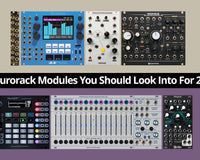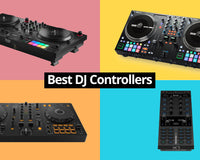In 2021 alone there has been a rapid increase in the number of people who make video calls, live streams, and podcasts. For the casual users, a built-in microphone in their device is adequate for the occasional family call, or trying out live streaming and podcasting.
If you are frequently making video calls for work, or have decided to get more serious about your live streaming and podcasting, it would be a smart idea to invest in a dedicated microphone.
Built-in mics have to deal with audio echo cancellation due to the fact that the device recording audio is also giving off audio from its speakers. Devices like laptops, phones and tablets are built with a mic that varies in quality. This is because the device’s main function is not to record audio, but to have a small manufacturing footprint, and low cost.
Getting audio into your computer requires three things: a quality mic, XLR cable, and sound/audio card. A USB mic simplifies this by having a sound card built into the mic, and replacing the XLR cable with a USB. A sound card uses an analog-to-digital converter (ADC, A/D, or A-to-D) to create the pulse-code modulation (PCM) which digitally represents the analog signal.
When looking at microphones, you will notice the term “polar patterns.” This refers to the directional pocket of where the mic “listens.” The three most common are omnidirectional, unidirectional, and bidirectional, however, a cardioid pattern is best suited for one person talking.
A cardioid mic’s pattern resembles a 3D heart, lying flat with its “V” pointing towards the person speaking. This is the ideal pattern for video calls, live streams, and podcasts as the mic captures everything in front of it (you talking) and blocks everything else (background noise).
Currently three companies are leaders in USB mics; Blue, RØDE, and Shure. Blue was founded in 1995 and was acquired by Logitech in 2018. RØDE was founded in 1967 as Freedman Electronics. Shure was founded in 1925 as The Shure Radio Company and made its first condenser microphone in 1932. Each company has a selection of mics that you can choose from.
BLUE
YETI Pro Studio ($390.00)

Blue’s Yeti Pro Studio mic was designed in 2009 with the sole purpose of being a professional multi-pattern USB mic for recording and streaming. Ten years later, the Yeti has become the world’s #1 USB microphone. The Yeti includes Blue’s proprietary tri-capsule technology, which is known for producing pristine, studio-quality recordings with ease.
This tri-capsule allows the mic to have four different pattern settings, giving you flexibility that would normally require multiple microphones. Mic patterns of the Yeti include: cardioid mode, stereo mode, omnidirectional mode, and bidirectional.
Switched to cardioid mode, the Yeti records sound sources that are directly in front of it. This is the ideal mode for podcasting, Twitch streaming, music recording, voice overs and instruments. Stereo mode gives you left and right channels, allowing you to capture a wide, realistic sound image which is good for immersive experiences like ASMR videos.
When switched to omnidirectional mode, the Yeti picks up sound equally from all around the mic. This setting is great for situations where you want to capture the ambience of "being there” which is ideal for recording a band's live performance, a multi-person podcast or a conference call. The last pattern to choose from is bidirectional which records from the front & back of the microphone, allowing for recordings which involve two speakers, like an interview.
On the front of the Yeti, you have a knob for headphone volume, which controls the built-in 3.5-millimeter headphone jack (located on the bottom). This allows you to monitor your recording in real-time without latency, and an instant mute button (great for when you need to sneeze).
On the back side of the mic, you have the pattern select and microphone gain knobs. The gain knob allows you to adjust the microphone's sensitivity while using the mic, which is very handy if you’re experiencing distortion or feedback while recording an especially loud source.
Blue has included a unique positionable stand/base with the Yeti, that lets you adjust and pivot the microphone. Once the mic is in the position you desire, hand-tighten the set knobs to secure it in place.
The microphone can also be folded down for easy portability. It can be removed completely from its stand/base, and mounted directly on a mic stand, or Blue’s own Radius II shock mount and Compass boom arm.
The tech specs include a frequency response of 20Hz - 20kHz and sample rate of 48 kHz/16 bit. As for system requirements, it is recommended you use Windows OS (10 or higher) or Macintosh macOS (10.13 or later) with a USB 1.1/2.0/3.0 female jack.
RØDE
NT-USB MINI ($129.00)
 In 2014, RØDE introduced a high-quality condenser capsule USB microphone that had a reasonable manufacturer suggested retail price (MSRP), and was simple to use. This mic was the NT-USB. In 2020, this well received mic was shrunken down and improved, then appropriately named the RØDE NT-USB Mini!
In 2014, RØDE introduced a high-quality condenser capsule USB microphone that had a reasonable manufacturer suggested retail price (MSRP), and was simple to use. This mic was the NT-USB. In 2020, this well received mic was shrunken down and improved, then appropriately named the RØDE NT-USB Mini! The high-quality condenser capsule inside the NT-USB Mini is known for its warmth and presence, giving you a clear & professional sound in most recording situations.
The NT-USB Mini has one polar pattern, directional cardioid, optimized to reduce room sound and focus on the subject. Built into the mic is a pop filter that reduces plosives (overloading of a microphone’s capsule).
Another feature that is built into the NT-USB Mini is a digital signal processing (DSP) that includes a noise gate, compressor, APHEX® Aural Exciter™ and Big Bottom™ (accessed via RØDE Connect).
Constructed out of matte black steel and reinforced nylon resin, the NT-USB Mini measures in at 89mm wide by 141mm tall. The mic also has an integrated 360-degree swing mount for quick and easy positioning on a desktop, mic stand, or studio arm.
RØDE has included a detachable magnetic desktop mic stand that they claim “provides excellent isolation from knocks and bumps.” In reality the isolation of the desktop mic stand is sub-par and does not position the mic in its ideal location (directly in front of the speaker’s mouth) as it is extremely short. This is fine as it seems more of a bonus and can easily be fixed by purchasing the RØDE PSA1 studio arm.
Located at the front of the mic near the bottom, you will find a level knob that controls the studio-quality headphone amplifier. To monitor your audio, simply plug your headphones into the 3.5mm jack at the back of the mic. If needed, the headphone amplifier can be switched to zero-latency mode, eliminating distracting echo when tracking.
You will also find on the back, the USB-C output connection. Packaged with your mic is a RØDE SC20, which is a Hi-Speed 1.5m USB-C to USB-A cable for connecting the NT-USB Mini to computers and devices with a USB-A input. The USB-C output is class-compliant allowing the mic to work seamlessly with computers or tablets with no drivers or software needed.
Tech specs on this mic include a frequency response of 20Hz - 20kHz and a sample rate of 48 kHz/24 bit. The operating system requirements for a PC are macOS 10.12 or Windows 10, and for iPhone/iPad the current iOS is needed.
PODCASTER ($299.00)
 The Podcaster mic was designed in Australia by RØDE, to deliver broadcast-quality audio with the simplicity of USB connectivity. This was achieved by pairing their 28mm dynamic capsule (cardioid polar pattern) with an audiophile quality 18-bit resolution, 48kHz sampling A/D converter. This allows the Podcaster to process all of the analogue-to-digital conversion internally, by-passing the computer's lower quality on-board sound controller altogether.
The Podcaster mic was designed in Australia by RØDE, to deliver broadcast-quality audio with the simplicity of USB connectivity. This was achieved by pairing their 28mm dynamic capsule (cardioid polar pattern) with an audiophile quality 18-bit resolution, 48kHz sampling A/D converter. This allows the Podcaster to process all of the analogue-to-digital conversion internally, by-passing the computer's lower quality on-board sound controller altogether. In addition to being designed in Australia, the Podcaster is also made there. This is reflected in the mics build quality as it is exceptional! Housed in an all-metal body, the Podcaster features an internal pop filter, designed to minimize plosive sounds that can overload the microphone capsule and distort the audio output.
To isolate the capsule from knocks and bumps, RØDE has developed an Internal capsule shock mount specifical for the Podcaster. To support their claim to quality, the Podcaster mic is covered by RØDE Microphones' industry leading 10-year warranty.
Similar to other USB mics, the Podcaster has a 3.5mm stereo headphone output built-in to the microphone body, providing zero-latency monitoring. This allows you to hear exactly what is being recorded and free of delay or echo. Above this jack is a volume control knob to adjust the headphone’s output level.
Tech specs on this mic include a frequency response of 40Hz - 14kHz and a sample rate of 44 - 96kHz/24 bit. The operating system requirements are Windows 7 or higher, Mac OS X devices (iPhone, iPad, and Mac PC), as well as several Linux distributions. It can also be used as an iPad microphone for the Apple iPad (in conjunction with the iPad Camera Connection Kit and a powered USB hub) to provide high quality recording to various iPad audio applications such as Garageband.
SHURE
MV51-DIG ($259.00)
 The MV51 is a digital large diaphragm condenser microphone that is best suited for the traveling user. With its small footprint (128 × 86 × 70 mm H × W × D), all metal construction and integrated rear kickstand (can convert to 5/8" thread to mount on any microphone stand), this mic can take a beating during your travels and work perfectly fine!
The MV51 is a digital large diaphragm condenser microphone that is best suited for the traveling user. With its small footprint (128 × 86 × 70 mm H × W × D), all metal construction and integrated rear kickstand (can convert to 5/8" thread to mount on any microphone stand), this mic can take a beating during your travels and work perfectly fine!
Shure has equipped the MV51 with its 1” (25mm) electret condenser capsule element, which has a unidirectional (cardioid) polar pattern. Some users find the singular polar pattern limiting.
To compensate for this, Shure has built in five DSP preset modes. You have the ability to choose from speech mode, singing mode, flat mode (raw audio w/ no effects), acoustic instrument mode, and loud mode (compensates for loud inputs). These modes can be selected by the middle button on the front panel touch control, with the current selection being indicated by a green LED.
This touch front panel also has the controls for the mic’s other features. Starting from the left, you will find the mute button, and to the far right you will find the headphone button. This controls your volume via the touch strip at the bottom when engaged (headphone jack can be found on the back of mic). When the headphone button is not engaged, the touch-strip controls the microphone’s gain.
Shure has packaged the MV51 with a micro-B-to-USB cable as well as a micro-B-to-lightning® cable. The latter cable is included due to the fact the MV51 is Apple MFi (Made for iPhone/iPod/iPad) Certified, allowing you to have a direct connection to any iOS device without the need for any additional adapters or connection kits.
Tech specs on this mic include a frequency response of 20 Hz to 20,000 Hz and a sample rate of 48kHz/24 bit. The operating system requirements are Windows 7 or higher, Macintosh OSX 10.7 or higher, iOS 7.0 or higher, and Android devices that support USB Audio Class 2.0 and Micro-B OTG (On-The-Go) connectivity.
MV7 ($319.00)
 Shure’s MV7 mic is essentially a USB version of their legendary SM7B mic. It features the same dynamic capsule (cardioid pattern), equipped with Shure’s Voice Isolation Technology to pick up sound directly in front of the microphone.
Shure’s MV7 mic is essentially a USB version of their legendary SM7B mic. It features the same dynamic capsule (cardioid pattern), equipped with Shure’s Voice Isolation Technology to pick up sound directly in front of the microphone.
This combination makes the MV7 ideal for close mic applications that require vocal intelligibility with a balanced tone. The most useful feature of this dynamic microphone is having both USB and XLR outputs, that can be used simultaneously, as well as the functionality to be used with computers and professional interfaces alike.
When connected via USB, Auto Level Mode is unlocked by the ShurePlus™ MOTIV app. While in Activate Auto Level Mode, select your preferred voice tone and distance from the microphone, so the microphone can adjust your level in real time for a consistent output, no matter if you’re recording or live streaming.
If you are not a fan of the AI, choose Manual Mode instead to have full control over your sound, with adjustments for Mic Gain, Monitor Mix, EQ, Limiter, Compressor and more.
While these settings are controlled through the ShurePlus™ MOTIV app, the MV7 has a touch panel in the middle of the mics housing. This provides control for the microphone’s gain, headphone level, monitor mix blend and muting.
The touch panel interface also features an LED bar, giving a visual representation of the microphone and headphone levels being displayed or adjusted. Green represents the microphone level; orange represents the headphone level, and a mix of green & orange represents the monitor mix blend level.
To adjust the monitor mix blend level, press and hold Monitor Toggle for 2 seconds. From here you can swipe left to hear more mic audio (green) or swipe right to hear more playback audio (orange). Press and hold the Monitor Toggle to return to separate microphone and headphone volume controls. This audio mix can be heard via the 3.5mm output jack located on the back of the mic.
At the back of the mic, you can also find the passive XLR output that can be used to connect the Shure mic to XLR mixers and interfaces (note: XLR audio is not affected by software settings). The Micro-B USB output is also located here, which is used to connect your computer to the MV7, using the included USB-A and USB-C cable.
Holding everything together is an attractive and durable all-metal designed housing, available in black or silver. This housing features an adjustable yoke that can be mounted onto a variety of microphone stands for flexible placement options as it has the standard 5/8-27 thread mount.
Shure also provides you with a windscreen, giving the MV7 maximum protection from plosives while creating a warmer, more intimate sound for speech applications, like podcasting and gaming.
Tech specs on this mic include a frequency response of 20 Hz - 20,000 Hz and a sample rate of 44.1 - 48kHz/16 - 24 bit. The operating system requirements are Windows 10 (64bit), Macintosh MacOS 10.13 to 10.15 (64bit), iOS 12 and higher on iPhone or iPod Touch 6th gen and up, and Android Oreo 8.0 and higher w/ USB Host Power Requirement of ≥100 mA & USB Audio Class 1.1 support and higher.








